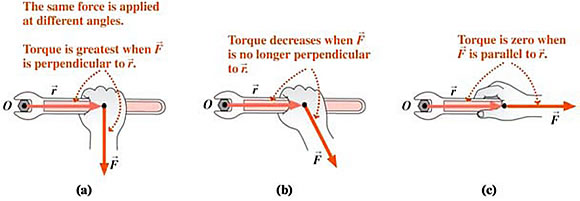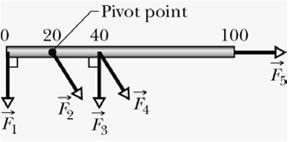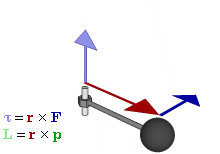The net force acting on a body accelerates it. But it takes
something to give the body an angular acceleration. A force is needed,
but it must be applied in a way that creates a twisting or turning
action. Torque, τ is the rotational version of force, and results from
the application of one or more forces. Torque is specified relative to a
chosen rotation axis or pivot.
Torque is dependent upon

 Definition: The torque produced by a force is defined by:
Definition: The torque produced by a force is defined by:
F┴ is the perpendicular component of the force (also known as the tangential component) and is called the lever arm or moment arm of the force. It is the perpendicular distance from the rotation axis to the line of action of the force.
Test your understanding:
The figure shows the top view of a horizontal metre stick (pivoted at the 20 cm mark) on which five horizontal forces of the same magnitude act. Which forces produce no torque? Rank the forces according to the torque they produce.


Torque is dependent upon
- The distance from the rotation axis to the force application point (Refer to first figure).
- The magnitude of the force, F.
- The orientation of the force relative to the displacement from the axis to force application point (refer to second figure).


τ = R x F → τ = R x F sinθ
The SI units of torque are Newton-metre (N.m).F┴ is the perpendicular component of the force (also known as the tangential component) and is called the lever arm or moment arm of the force. It is the perpendicular distance from the rotation axis to the line of action of the force.
Test your understanding:
The figure shows the top view of a horizontal metre stick (pivoted at the 20 cm mark) on which five horizontal forces of the same magnitude act. Which forces produce no torque? Rank the forces according to the torque they produce.


read more on (Torque)





This content is very unique. I liked this too much. I really appreciate this. Thank you for sharing this information. This is very informative content. Hoped you like my comment. We offered soundproof materials for cars and home like sound deadening mats. thermal insulation materials
ReplyDelete